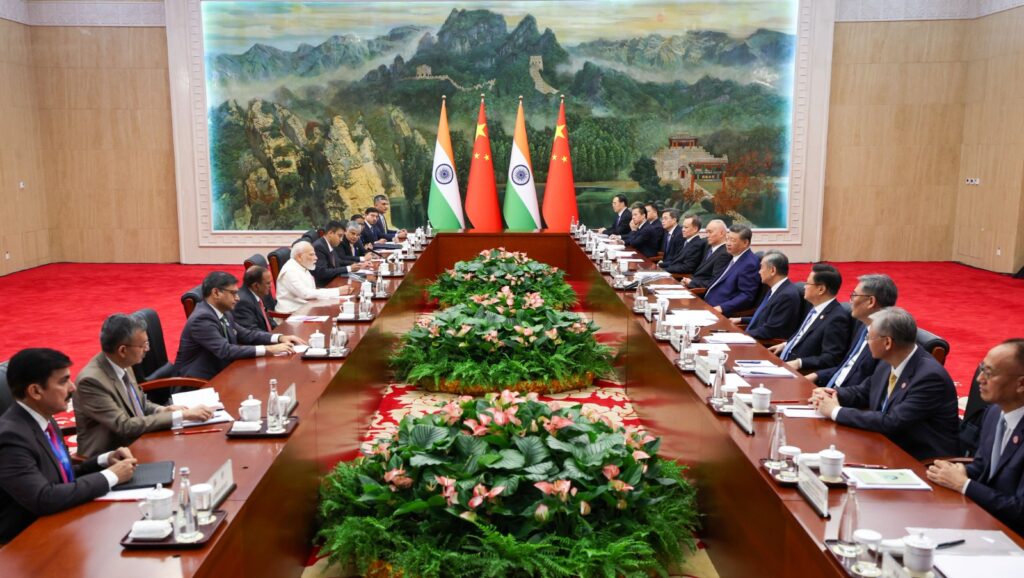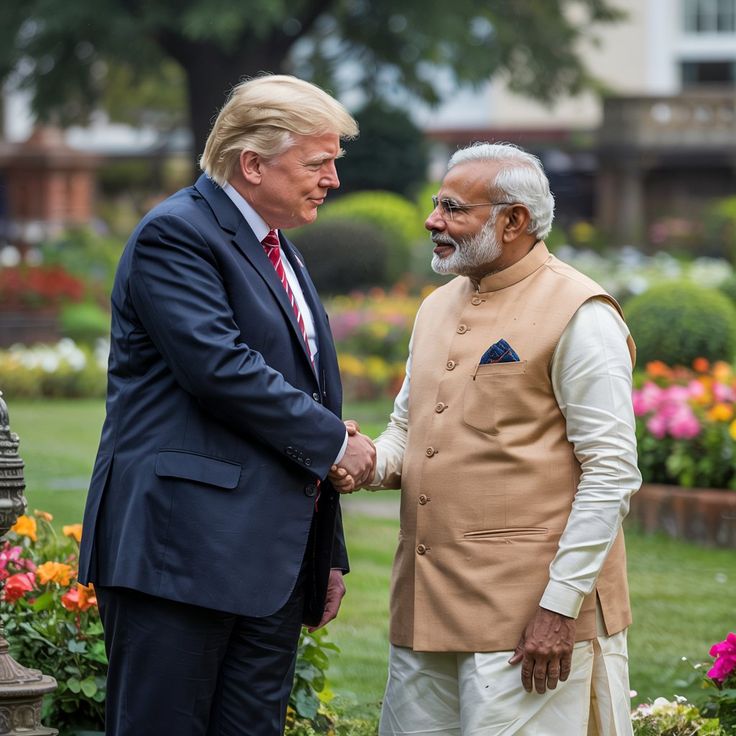In what could be one of the most defining diplomatic engagements of recent years, Prime Minister Narendra Modi and Chinese President Xi Jinping held a crucial bilateral meeting in Tianjin, China. The high-profile dialogue comes at a time when the relationship between the two Asian giants has been strained due to long-standing border disputes, economic competition, and regional security concerns. Yet, the meeting in Tianjin suggests both sides may be ready to recalibrate ties and move towards a more stable partnership rooted in mutual understanding and cooperation.
A Meeting of Global Stakes
The India–China relationship is not just a bilateral equation; it is one of the most significant geopolitical dynamics of the 21st century. Two of the fastest-growing economies and more than one-third of the world’s population are shared by China and India. Their cooperation, or lack thereof, has direct consequences for global trade, regional stability, and international politics.
The Tianjin meeting was, therefore, not only a gesture of diplomacy but also a signal to the world that both nations recognize the need to balance rivalry with collaboration. For India, a stable relationship with China could ensure peace at the borders, reduced military expenditure, and greater economic opportunities. For China, strengthening ties with India could prevent its increasing isolation in the Indo-Pacific, particularly as the U.S. strengthens strategic ties with New Delhi through the Quad alliance.
Why Tianjin Matters
Tianjin’s selection as the location is symbolic in and of itself. As one of China’s major coastal cities, Tianjin represents China’s modernization, industrial development, and global connectivity. Hosting the Indian Prime Minister in this city underlines Beijing’s intention to showcase its economic achievements and position China as a cooperative global power, despite rising international scrutiny.
For Modi, attending the meeting in Tianjin after years of limited direct bilateral engagements highlights India’s willingness to explore pragmatic diplomacy. It sends a clear signal that India is prepared to engage constructively, provided that China shows sincerity in addressing India’s security concerns, especially along the Line of Actual Control (LAC).
The Key Agendas on the Table
The Modi–Xi dialogue in Tianjin revolved around several pressing issues that have shaped India–China ties in recent years:
1. Border Peace and the LAC Dispute
The foremost issue between India and China is the ongoing border standoff, particularly in Ladakh and Arunachal Pradesh. The violent clashes in Galwan Valley in 2020 deeply strained ties, resulting in casualties on both sides and a dramatic deterioration in trust.
Modi stressed the significance of reestablishing peace and serenity along the borders as the “foundation” of stable relations during the meeting in Tianjin. Reports indicate that both leaders agreed to intensify military-level talks to prevent accidental escalations and maintain open communication channels between commanders on the ground.
For India, border peace is non-negotiable. Without it, cooperation in other areas such as trade or cultural exchanges cannot flourish. China, on its part, has reportedly expressed willingness to “work together for de-escalation,” though its exact commitment remains to be tested in the coming months.
2. Trade and Economic Engagement
Bilateral trade between India and China has surged in recent years, crossing over $136 billion in 2023. India still has a large trade imbalance in favor of China since it buys a lot of electronics, machinery, and medications while exporting very little.
In Tianjin, Modi is believed to have pressed for more balanced trade relations and greater market access for Indian goods and services. Sectors like IT, pharmaceuticals, and agricultural products remain key areas where India wants China to ease restrictions.
Xi Jinping responded by underscoring China’s intention to continue supporting India’s industrial sectors and infrastructure. While geopolitical tensions often spill over into economic policy, both leaders acknowledged the importance of keeping trade channels open in order to strengthen people-to-people and business ties.
3. Regional Security and Global Geopolitics
China and India are frequently on opposing sides of regional disputes. While China maintains close ties with Pakistan and has invested heavily in the China–Pakistan Economic Corridor (CPEC), India has strengthened its partnerships with the U.S., Japan, and Australia through the Quad grouping.
The Tianjin talks reportedly touched upon reducing tensions in the Indo-Pacific, where both powers have competing visions of security and influence. Modi stressed India’s “free, open, and inclusive” approach to the Indo-Pacific, while Xi reiterated China’s concerns about “containment strategies” directed at Beijing.
While differences remain, the meeting indicated a mutual recognition that open confrontation benefits neither country, particularly at a time when global economic recovery remains fragile.
4. Climate Change and Multilateral Cooperation
Beyond contentious issues, both India and China see opportunities for collaboration in global forums such as the G20, BRICS, and the Shanghai Cooperation Organization (SCO). Climate change, sustainable development, and energy transition are areas where cooperation could strengthen their international standing.
At Tianjin, the two leaders reaffirmed their commitment to climate goals under the Paris Agreement, acknowledging that as the world’s two largest developing economies, they share a responsibility to balance growth with sustainability.
The Symbolism of Personal Diplomacy
The close relationship between Modi and Xi was one of the most notable features of the Tianjin conference. Both presidents understand the importance of personal diplomacy and optics, despite the fact that relations between Beijing and New Delhi have sometimes been characterized as “adversarial.”
Modi and Xi have met multiple times since 2014, most notably during unofficial summits in Wuhan (2018) and Mamallapuram (2019). But these discussions had been halted by the border conflicts. The fact that direct communication is being resumed in 2025 is interpreted as a significant indication that high-level personal interaction is still an essential diplomatic tactic.
Analysts believe that while personal rapport cannot solve structural disputes, it can create the political will necessary for bureaucrats, diplomats, and military commanders to work on solutions without the pressure of open hostility.
Reactions at Home and Abroad
Both domestically and internationally, the Tianjin summit has sparked intense reactions.
In India, political leaders and analysts have cautiously welcomed the development, while emphasizing the need for “trust, not just talks.” Critics argue that China’s past behavior—such as building military infrastructure near the LAC even during talks—should make India wary of empty promises.
In China, state media hailed the meeting as a “new chapter in bilateral friendship,” portraying it as evidence of Beijing’s global leadership and willingness to resolve disputes peacefully.
The United States and European powers are keeping a careful eye on the situation on a global scale. Washington, which has deepened strategic cooperation with India in recent years, is keen to understand whether New Delhi’s engagement with Beijing could alter the balance of power in the Indo-Pacific. Meanwhile, Russia, a longtime ally of both countries, has quietly welcomed the dialogue, seeing it as a stabilizing factor in Eurasia.
Challenges Ahead
Even with the Tianjin summit’s favorable appearance, there are still several obstacles to overcome:
Trust Deficit: Decades of suspicion cannot be erased overnight. India remains cautious about China’s strategic ties with Pakistan and its Belt and Road Initiative projects in disputed territories.
Border Management: Concrete steps are required on the ground to ensure disengagement and prevent future clashes. Confidence-building measures, such as joint patrolling or communication hotlines, will need to be implemented.
Economic Imbalance: India’s domestic worries over its reliance on Chinese imports may stoke political backlash if trade deficits are not reduced.
Geopolitical Alignments: India’s participation in the Quad and China’s assertiveness in the South China Sea will continue to influence relations.
A New Chapter or Another Pause?
Although decades of animosity may not be resolved, the Modi-Xi encounter in Tianjin has created a window for cautious optimism. By agreeing to re-engage at multiple levels, both leaders have signaled that confrontation is not inevitable, and dialogue remains the preferred path.
For India, the priority remains peace along the border, which forms the bedrock of any long-term cooperation. For China, engaging India constructively could help offset international criticism and prevent strategic isolation.
Whether Tianjin will be remembered as a turning point in India–China ties or just another temporary pause in hostilities will depend on the sincerity with which both nations follow up on their promises.
The pragmatic understanding of common interests in stability, economic progress, and regional peace is evident in the Tianjin meeting between President Xi Jinping and Prime Minister Modi. Even while there are still enduring issues, the readiness to participate shows that diplomacy may still influence Asia’s destiny.
In a world increasingly defined by rivalries and power shifts, the India–China relationship will remain one of the most closely watched equations. The Tianjin dialogue is a reminder that even the most complex disputes can find space for dialogue, if leaders are willing to look beyond immediate differences toward the larger goal of peace and stability.
Related News: Read More




Pingback: CP Radhakrishnan as 15th Vice President